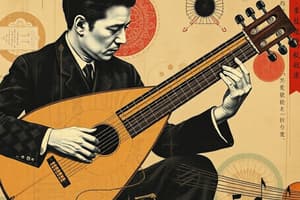Podcast
Questions and Answers
Which of the following descriptions pertains to Chong-ak?
Which of the following descriptions pertains to Chong-ak?
- It is the music of common folk.
- It means 'right music'. (correct)
- It pertains to ensemble music for men of high social status outside of the court. (correct)
- It is the music correlated with the ruling classes. (correct)
What distinguishes the northern style of singing from the southern style?
What distinguishes the northern style of singing from the southern style?
- The northern style tends to be higher and more shrill than the southern style. (correct)
- The northern style uses only guttural sounds.
- The southern style incorporates more instruments.
- The northern style is slower and more melodic.
Which instrument is classified as a membranophone?
Which instrument is classified as a membranophone?
- Pipa
- Taiko (correct)
- Shamisen
- Hichiriki
Why is understanding the Hornbostel Sachs classification of East Asian musical instruments important?
Why is understanding the Hornbostel Sachs classification of East Asian musical instruments important?
What is true about the musical elements represented after listening to the music?
What is true about the musical elements represented after listening to the music?
How does Confucius view the role of music in society?
How does Confucius view the role of music in society?
What is the role of the 'shamisen' in Japanese traditional music?
What is the role of the 'shamisen' in Japanese traditional music?
Which of the following instruments does not belong to the chordophone category?
Which of the following instruments does not belong to the chordophone category?
Flashcards
Chong-ak characteristics
Chong-ak characteristics
Chong-ak is music associated with high-class people, often courtly or royal, and considered 'right music'.
Northern vs. Southern singing styles
Northern vs. Southern singing styles
Northern singing styles are often perceived as higher and more shrill compared to Southern styles.
Hornbostel-Sachs classification
Hornbostel-Sachs classification
A system for classifying musical instruments based on their sound-producing mechanisms.
Musical elements in East Asian music
Musical elements in East Asian music
Signup and view all the flashcards
Confucius on Chinese music
Confucius on Chinese music
Signup and view all the flashcards
Yin and Yang in Chinese music
Yin and Yang in Chinese music
Signup and view all the flashcards
Shamisen in Japanese music
Shamisen in Japanese music
Signup and view all the flashcards
Chordophone instruments examples
Chordophone instruments examples
Signup and view all the flashcards
Study Notes
Chong-ak
- It is music associated with the ruling class.
- It is ensemble music for men of high social standing, performed outside the royal court.
Northern vs. Southern Singing Styles
- Northern singing is typically higher-pitched and more shrill than the southern style.
Musical Instrument Classification
- Membranophone: An instrument that produces sound by vibrating a stretched membrane (e.g., drums).
Hornbostel-Sachs Classification
- It categorizes instruments based on their sound production method, helping to understand how instruments work.
Musical Elements After Listening
- Vocal tone (timbre) may be nasal and throaty.
- Rhythmic patterns use duple, triple, or quadruple time signatures.
- Melodies are often pentatonic and diatonic.
- Musical form is often strophic.
Chinese Music Philosophy
- Confucius saw music as a way to calm emotions and reduce unrest.
Yin and Yang in Chinese Music
- The interaction between instruments, melody, and rhythm creates harmony and balance, reflecting the principles of Yin and Yang.
Japanese Shamisen
- The shamisen is a primary melodic instrument in genres like "bunkaku" and "kabuki."
- Its sharp, percussive sound adds emotional depth to the performance.
Chordophone Instruments
- Examples of chordophones include the Kayagum, Pipa, and Biwa.
Aerophone Instruments
- Japanese aerophones include the Hichiriki and Sho.
Studying That Suits You
Use AI to generate personalized quizzes and flashcards to suit your learning preferences.
Related Documents
Description
Explore the fascinating world of Chinese music, including the unique classifications of instruments, the contrasting Northern and Southern singing styles, and the philosophical aspects of music as envisioned by Confucius. Delve into essential musical elements and cultural significance to gain a deeper understanding of this rich musical heritage.




